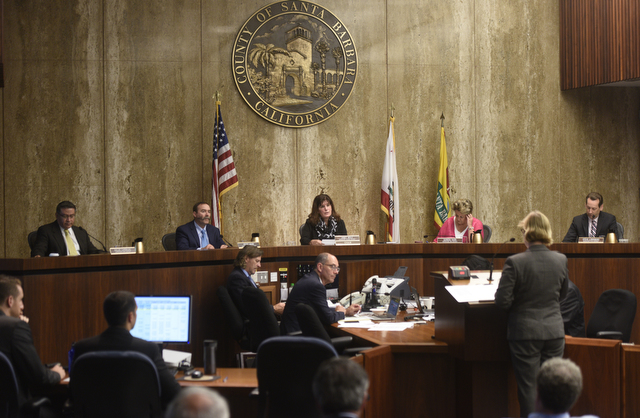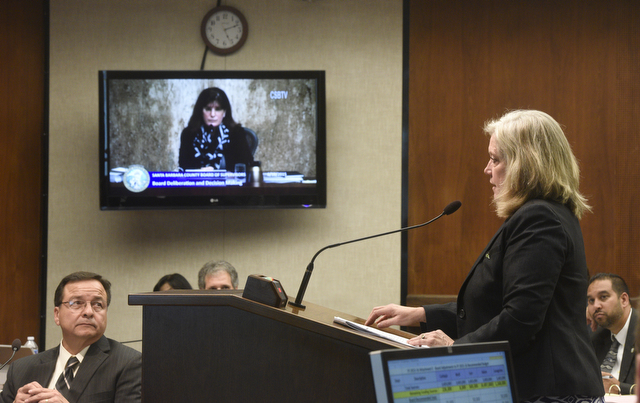Laura’s Law on the Books?
Supervisors Approve Nearly a Billion-Dollar Budget

About seven hours into this week’s budget hearing, Supervisor Doreen Farr pulled off a stealth move when she allocated $121,000 to take initial steps to enact Laura’s Law.
In April, the supervisors held off on implementing the measure — which would allow judges to order mentally ill people who pose safety risks into treatment programs — after Alice Gleghorn, the Alcohol, Drug, and Mental Health Services (ADMHS) director hired six months ago, told the supes that her department was already slammed with the reform programs she was hired to carry out.
“I am still working on the last priorities you asked me to do,” Gleghorn told the supervisors on Wednesday, echoing remarks she made in April.
Laura’s Law dates back to 2002, when the Legislature passed a measure named after one of the victims in a shooting in Nevada City in 2001, 19-year-old Laura Wilcox. Counties can choose to enact these assisted outpatient treatments. According to the Treatment Advocacy Center, nine counties in the state have implemented the measure as of June 1.

On Tuesday, at a press briefing, Gleghorn updated reporters on the department’s new services; these include the formation of crisis triage teams to proactively seek out people who might need treatment as well as the opening of two housing facilities that folks can voluntarily check themselves into. When asked about the future potential of Laura’s Law, Gleghorn told reporters she would return to the board in six months with a progress update on changes in the system. “We will see,” she said.
But on Wednesday, three of the five supervisors okayed money for a program design, which is just short of adopting the measure. Farr noted that a lot of people in the community had asked for it, and she and District Attorney Joyce Dudley took the issue up again after Isla Vista’s shooting rampage in May 2014.
“It’s merely an opportunity,” said Farr, who added she had let Gleghorn know she would put it on the menu of additional things to fund. “I think it’s really important,” she said, stressing that this is the very initial step. “If the money is not there, there’s not even a possibility to consider it.”
But Gleghorn, who was called up to the podium, said she was “very anxious,” suggesting that the push for Laura’s Law stemmed from “pent up expectations.”
“It’s unrealistic for us to be looking at this change within a 12-month period,” she said. “We are still swimming as fast as we can to do all of the things you requested a year ago.”
Supervisors Janet Wolf and Peter Adam — usually political opposites — iterated these points, both saying they’d like to wait for Gleghorn to return to the board when she’s ready. “It’s really surprising to me,” said Wolf of Farr’s move.
The decisive vote was Supervisor Steve Lavignino, who expressed some hesitation. He emphasized that he did not want to attach a timeframe for implementing the measure. “This is the time we have some funding,” he said. “We might not have that funding next year.”
For Laura’s Law to be enacted in Santa Barbara County, the matter would have to return to the board for vote; a 3-2 vote would be required.
Ag Commissioner

It’s not often that Hillary Blackerby and Andy Caldwell are in the same camp. But at this week’s budget hearing, Blackerby, an aide to Assemblymember Das Williams, and Caldwell, cofounder of COLAB, told the supervisors to keep the two full-time Ag positions, both experts in their specific fields. “Plants need doctors,” said Caldwell. Several speakers echoed this remark, warning about invasive species ruining large areas for agriculture.
Despite the objection, the supervisors approved Agricultural Commissioner Cathy Fisher’s recommendation that a full-time entomologist and pathologist position be cut in half — and combined to one full-time position. The $57,000 in savings will fund a new biologist position at a reduced salary.
Who Pays for Isla Vista?
A string of public speakers made their way to the podium to encourage the supes to set aside $483,000 to refurbish the Isla Vista Clinic Building and nearby church building — once owned by Santa Barbara’s Redevelopment Agency (RDA), then by the county after the state dissolved all RDAs — to function as community centers. Part of the I.V. Clinic Building is currently used as a gathering space. “We need to see Isla Vista as a place where change is possible,” said Jeremy Roark, a psychologist at CAPS (Counseling & Psychological Services).
George Thurlow — UCSB assistant vice chancellor for alumni affairs and appointed last year to be the chancellor’s special assistant on Isla Vista affairs — also made a plea for the community centers. He went on to tell the supervisors that UCSB has spent $283 million over the last decade, including $5.8 million on El Colegio Road, $10 million for the Foot Patrol, and $3.3 million for fire and ambulance services. Future university dollars, Thurlow said, will go toward subsidizing MTD bus routes and public works programs in I.V.
Over the next decade, UCSB will expand by 5,000 undergrads and hundreds of faculty and staff — along with buildings and housing to hold them — per its long-range development plan definitively approved last November.
Others championed a community resource deputy — $114,000 annually — to work for the Isla Vista Foot Patrol. Second District Supervisor Janet Wolf was the decisive vote. She expressed concern that the Sheriff’s Office indicated in a board inquiry form that UCSB’s Police Department was not meeting officer staffing requirements; but she was swayed after several UCSB students called her during the break. The supervisors approved both for Isla Vista.
Community Choice Aggregation
The supervisors funded a $335,000 technical feasibility study for Community Choice Aggregation and a $165,000 ongoing cost of project management. In 2002, the State Legislature passed a bill that permits local agencies to buy electricity wholesale—including from alternative sources — and sell it to its customers while existing utility companies continue to bill and provide the energy. Several speakers took to the podium to support renewable energy.
Total Approved Nearly $1 Billion
The supervisors voted 4-1 to approve a $965 million operating budget. Fourth District Supervisor Peter Adam voted against the budget for the third year in a row, calling for $7.9 million in infrastructure updates. Calling the budget as tight as a wedge, Adam said the county was “totally inadequately dealing with maintenance in a real way.” The supervisors also funded a $160,000 environmental attorney for possible oil spill litigation, $391,000 for the county’s libraries, $200,000 in parks maintenance, and $275,000 for park rangers.



